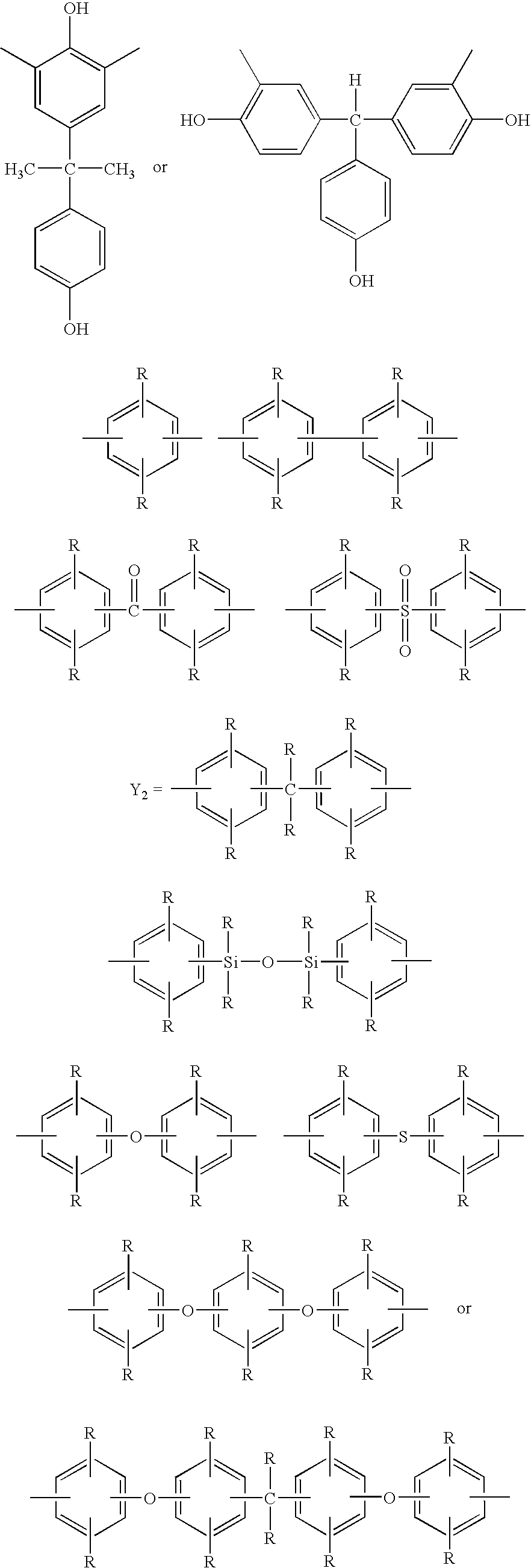Wafer dicing/die bonding sheet
a technology of die bonding and waxing, which is applied in the direction of heat-activated film/foil adhesives, film/foil adhesives, synthetic resin layered products, etc., can solve the problems of loss of bonding force, insufficient polyimide resins to mitigate thermal stress, and insufficient cure properties
- Summary
- Abstract
- Description
- Claims
- Application Information
AI Technical Summary
Benefits of technology
Problems solved by technology
Method used
Image
Examples
synthesis example 1
[0062] A 1-liter separable flask equipped with a 25-ml water metering receiver coupled to a reflux condenser through a cock, a thermometer and a stirrer was charged with 44.03 parts of a diaminosiloxane (linear dimethylpolysiloxane blocked with a .gamma.-aminopropyldimethylsiloxy radical at each end of the molecular chain, KF-8010 by Shin-Etsu Chemical Co., Ltd.) and 100 parts of cyclohexanone as a reaction solvent. By stirring at 80.degree. C., the diaminosiloxane was dispersed. A solution of 38.72 parts of 6FDA (2,2-bis(3,4-dicarboxyphenyl)hexafluoropropane) as an acid anhydride in 100 parts of cyclohexanone was added dropwise to the dispersion. The solution was stirred for 8 hours at 80.degree. C. for reaction, thereby synthesizing an acid anhydride-rich amic acid oligomer.
[0063] Next, a 1-liter separable flask equipped with a 25-ml water metering receiver coupled to a reflux condenser through a cock, a thermometer and a stirrer was charged with 17.25 parts of a phenolic hydroxyl...
synthesis example 2
[0065] In a flask equipped with a stirrer, thermometer and nitrogen purge line, 29.42 g (0.10 mol) of 3,3',4,4'-biphenyltetracarboxylic acid dianhydride, 7.46 g (0.03 mol) of 1,3-bis(3-aminopropyl)-1,1,3,3-tetramet-hyldisiloxane, and 28.73 g (0.07 mol) of 2,2-bis(4-(4-aminophenoxy)phenyl)-propane in 196.8 g of N-methyl-2-pyrrolidone were reacted at room temperature for 12 hours, yielding a polyamic acid solution. Toluene, 30 g, was added to the polyamic acid solution, and reaction effected at 200.degree. C. for 3 hours. It was confirmed that a predetermined amount of water collected in the water metering receiver and the outflow of water ceased. While the water metering receiver was freed of the effluent, the toluene was removed completely at 160.degree. C., yielding a polyimide resin solution. At the end of reaction, the solvent was distilled off from the solution, and vacuum drying yielded the polyimide resin.
[0066] The infrared absorption spectrum of the polyimide resin was measu...
example 1
[0067] In 600 parts of cyclohexanone were dissolved 100 parts of the polyimide resin obtained in Synthesis Example 1, 71.3 parts of o-cresol novolac epoxy resin EOCN1020 (by Nippon Kayaku Co., Ltd., epoxy equivalent 220 g / Eq), 27.7 parts of a phenol novolac resin TD2131 (Dainippon Ink & Chemicals, Inc., phenolic hydroxyl equivalent 110 g / Eq), 1 part of triphenylphosphine TPP (Hokko Chemical Co., Ltd.) as the curing catalyst and 1 part of 3-glycidoxypropyltrimethoxy-silane as the silane coupling agent. There was obtained an adhesive composition varnish.
PUM
| Property | Measurement | Unit |
|---|---|---|
| molar ratio | aaaaa | aaaaa |
| temperature | aaaaa | aaaaa |
| temperature | aaaaa | aaaaa |
Abstract
Description
Claims
Application Information
 Login to View More
Login to View More - R&D
- Intellectual Property
- Life Sciences
- Materials
- Tech Scout
- Unparalleled Data Quality
- Higher Quality Content
- 60% Fewer Hallucinations
Browse by: Latest US Patents, China's latest patents, Technical Efficacy Thesaurus, Application Domain, Technology Topic, Popular Technical Reports.
© 2025 PatSnap. All rights reserved.Legal|Privacy policy|Modern Slavery Act Transparency Statement|Sitemap|About US| Contact US: help@patsnap.com



